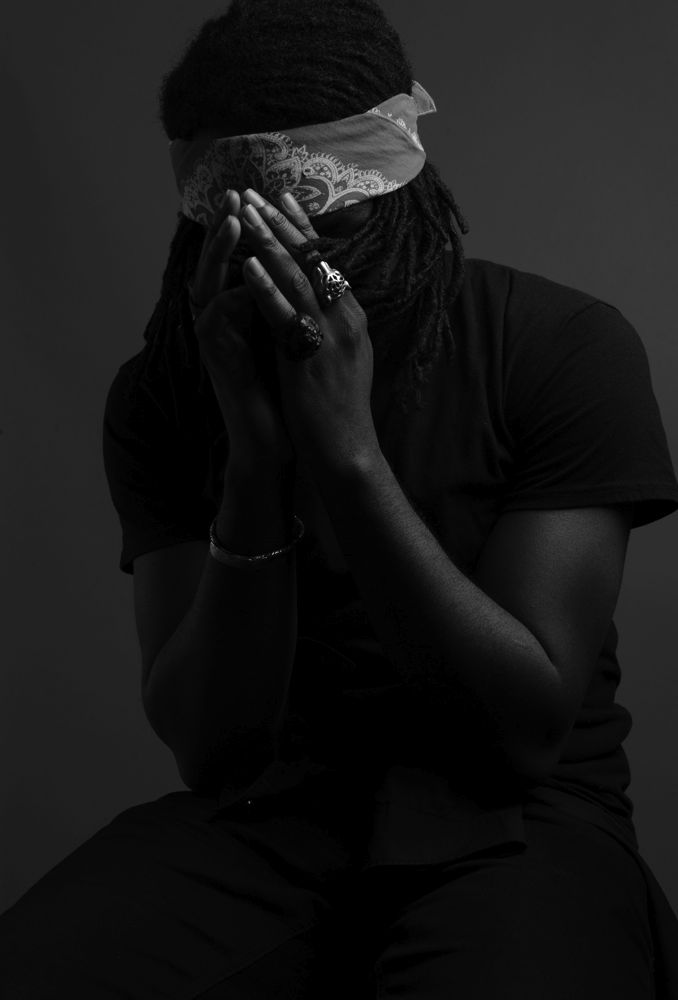Exclusive Video Premiere and Interview: ‘Handle It,’ MeLo-X

ABOVE: MELO-X. PHOTO COURTESY OF SARAH KJELLEREN.
MeLo-X is everything you’re looking for in an indie rap artist. He has an eclectic sense of style and an aesthetically pleasing Tumblr. He hangs out with other notable indie artists, like Jesse Boykins III. His production is unexpected and groovy, and his lyrics are poetic, eloquent, and thoughtful—even when the subject matter is intergalactic strippers.
MeLo-X’s career has developed organically rather than explosively—a trajectory he explores via his recent three-EP series, titled GOD: LoFi, GOD: HiFi, and GOD: WiFi. The series tells the story nearly all artists of the Internet age can relate to; a rise to success via perseverance, hustling, vision, and talent that is increasingly dependent on online channels. Since MeLo-X gained international recognition for his remix of Maxwell‘s Grammy-winning BLACKsummers’night—a project of which Maxwell himself is a fan—his following has steadily grown. His unwillingness to capitalize on hype and desire to consistently outdo, however, suggests an artist likely to enjoy a long, varied and prosperous career.
Premiering here, MeLo’s video for Handle It does not rehash the classic elements of a rap video (i.e. scantily clad women, champagne, and tricked out cars). Instead, it reads like a fashion film, which comes as little surprise as its director Paul Jung has shot for the likes of Vogue and Glamour. We caught up with the Brooklyn-based rapper to chat about the video, the indie rap game, and his unexpected career fallback.
ALLYSON SHIFFMAN: Do you identify as a “rapper?”
MELO-X: I would say I’m a creator. That’s how I introduce myself nowadays, because I do too many different creative things to run down the list but to say just one thing would be discrediting myself. So I say I’m a creator.
SHIFFMAN: Your three-part EP series, GOD, tell the story of an indie artist rising to fame. What did this trajectory look like for you?
MELO-X: I started to DJ a lot more in the city around 2006. Then I started doing remix projects. First I remixed an Amy Winehouse album, then Raphael Saadiq—artists like that. Then I put out a mixtape and then the Maxwell remix project in 2009. Between all that time, I started traveling around the country and internationally, and when that project came out, it was the absolute highlight up until that point. Maxwell hit me up personally about it. He had just heard one song and was like, “Let me hear the whole thing.” Then a few months later Sony bought some of the remixes and used it on Maxwell’s tour—at the end of his shows, they would play one of my remixes. My friend hit me up one day and said she had heard one of my remixes at Madison Square Garden, so that was kind of cool. Since then I’ve just been travelling around the world doing different EPs, collaborations and remixes for different artists. The indie route has been really good for me—just living independently and traveling. Through this, I was able to put together this three-part EP series that tells the story of an artist’s rise to fame.
SHIFFMAN: I wanted to talk to you about process. Do you write things down?
MELO-X: The majority of what I do is in my head, but I usually write when I’m in transit—on a train or a plane. I’ll write it in my head and then I’ll write it down real quick so I don’t forget it. I produce in my head too. I’ll have the beat and the song.
SHIFFMAN: In the description of the GOD series, you talk about fate and the ways in which our lives are written out for us. Do you believe your personal journey as an artist is predetermined in some way or that the steps you’ve taken actively have brought you to this point?
MELO-X: I think it’s a balance of both. If you take certain actions, what’s supposed to happen will happen. If you pray every day for something, it might not happen as quickly as you praying and going out to make it happen.
SHIFFMAN: I find your Tumblr to be very well curated. What informs your aesthetic?
MELO-X: As far as my aesthetic online, the main thing is my travels. In terms of what I wear, it always has an international focus. I like to collect things from different places. I do photography as well, so I have a big archive of photos from everywhere I’ve been for the past seven years.
SHIFFMAN: Along that same vein, although it’s definitely not a new thing for rappers to speak materialistically, now more and more of the brands mentioned seem to be avant-garde as opposed to simply expensive. Why do you think the rap world and the fashion world are become more and more intertwined in this way?
MELO-X: A lot of artists who are not pigeonholed to a label or a certain style or a certain sound feel more open to speak freely about the things that they’re inspired by. A lot of times the music on the radio—what the mainstream rappers of the time are talking about—a lot of the indie guys don’t associate or connect with. Last year every big-name rapper on the radio was talking about “red bottoms,” but if you listen to up-and-coming artists that are more Internet-based, they were talking about a range of things more specific to their personal style.
SHIFFMAN: What led you to choose a fashion photographer to shoot “Handle It,” rather than someone with more experience directing rap or other music videos?
MELO-X: With everything I do, I try to take it to another level; I’m in competition with myself. Since I started creating music, I always wanted to do a video that pushes the envelope in this way but I didn’t have the resources and didn’t know the right people. Last year it was a sequence of meeting the right people. I met this dope photographer and artist named Awol, and he introduced me to Erin Wahed, who then introduced me to Paul. Paul was perfect because his style and his aesthetic was exactly what I wanted.
SHIFFMAN: Before you come in, the video looks like a fashion film for Erin’s jewelry line, Bande Des Quatres.
MELO-X: [laughs] That’s exactly what we wanted to do. I’ve always tried to be different. My boys in the hood were like, “You’ve got to have some big booty hoes in the video.” For me, I wanted to tell this story in a different way.
SHIFFMAN: [laughs] So, what is the story you’re telling in the video for Handle It?
MELO-X: The song is about me meeting a stripper from Mars and her taking me to her planet. So the video needed to portray this, but we didn’t just want a beautiful woman dancing. We were thinking of ways to make her look like she wasn’t human, so we thought, “What if she’s in a cocoon?” All of these different ideas started bouncing around, and I think in the end we portrayed it to a T.
SHIFFMAN: So you mentioned you DJ quite a bit as well. Where do you look for music?
MELO-X: I’m usually searching Soundcloud and Hype Machine. I have a lot of friends sending me music and updating me on what’s new. When I’m out at clubs I like to see what the crowd vibes off of and if I like it, I’ll play it. I’ll never play something I don’t like just because it’s popular.
SHIFFMAN: What advice would you give yourself now when you were first starting out?
MELO-X: Be patient, it’s going to be a longer road the route you’re going but it’s going to pay off, so it’s all good.
SHIFFMAN: What do you think you’d be doing professionally if you weren’t doing this?
MELO-X: I’d be a ghost. [laughs] No, no, if I had to choose I’d be a computer engineer.
SHIFFMAN: Whoa, that’s ambitious.
MELO-X: I was into computer programming in high school.
SHIFFMAN: Are you an optimist or a pessimist?
MELO-X: Definitely an optimist. I’m always looking forward.
FOR MORE ON MELO-X, VISIT HIS WEBSITE.






